
What Foods Make Your Butt Bigger? | 10 Amazing Foods for a Bigger Butt
Are you on a journey to shape up your glutes and achieve that voluptuous, attractive figure you’ve always desired? Well, you’re in the right place. Achieving a fuller, firmer booty might be easier than you think, and guess what? It starts right in your kitchen!
Surprised? Don’t be. Certain foods can assist you in enhancing your curves, specifically your butt size. These are the kind of foods packed with the right nutrients that support muscle growth and fat distribution – the two crucial factors responsible for the shape of your derriere.
Among the myriad of exercises and fitness routines, you’ve got to pay close attention to the signs your glutes are growing. You’ll notice these signs when you integrate specific foods into your diet, and we’re here to reveal the secret. We’ve hand-picked 10 amazing foods that can help you sculpt your butt into a dreamy, rounded shape. Not only will these foods aid your fitness journey, but they’ll also ensure a nutritious, balanced diet.
You may also like to read Weight Watchers vs Keto: How to Choose the Best Diet Plan.
Ready to dine your way to a bigger butt? Let’s dive into the ultimate guide that combines delicious food with achieving your body goals!
Chicken Breast
Chicken breast is the quintessential protein-rich food, a staple for bodybuilders and fitness enthusiasts alike. It’s low in fat, high in protein, and loaded with a variety of essential nutrients.
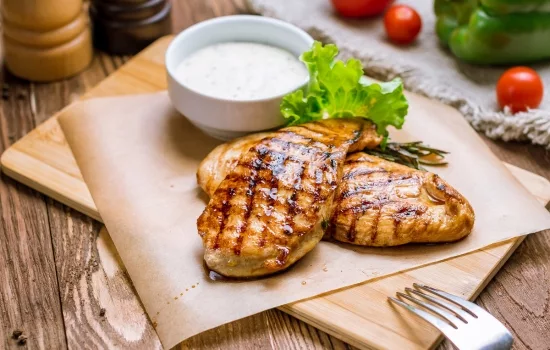
Nutritional Information (100g of Cooked, Skinless Chicken Breast):
Calories: 165 Carbohydrates: 0g Protein: 31g Fat: 3.6g
Micronutrients: Niacin, vitamin B6, phosphorus, selenium, and vitamin B12.
How Can Chicken Breast Help Enhance My Physique?
Chicken breast is brimming with high-quality protein, which contains all the essential amino acids your muscles need to repair and grow. Regular consumption can stimulate muscle synthesis, aiding in your physique development, particularly in areas like your glutes.
Sweet Potatoes
Sweet potatoes are a nutritional powerhouse, packed with a multitude of vitamins, minerals, and antioxidants. They are a great source of complex carbohydrates, which release energy gradually, making them a perfect pre-workout food.
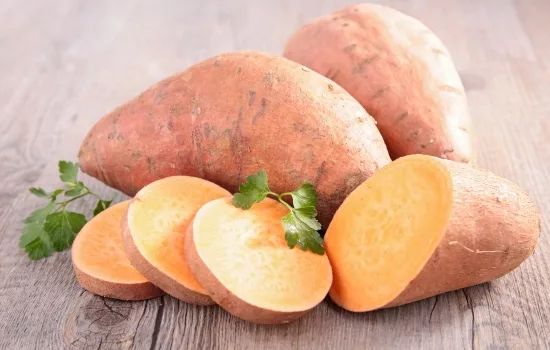
Nutritional Information (1 Medium Sweet Potato):
- Calories: 103 Carbohydrates: 24g Protein: 2.3g Fat: 0.2g
- Micronutrients: Vitamin A, vitamin C, manganese, fiber, potassium, and antioxidants.
How Can Sweet Potatoes Contribute to Muscle Growth?
The slow-releasing carbs in sweet potatoes provide a steady energy source during workouts, while its dietary fiber aids in digestion and absorption of nutrients. This allows your muscles, including your glutes, to get the fuel they need for growth and recovery.
Also read The Best Foods Good for Skin: Make Your Skin Healthy.
Cottage Cheese
Cottage cheese is an excellent source of casein protein, which is a slow-digesting protein. It’s perfect for nighttime snacking as it provides a steady supply of amino acids while you sleep, promoting muscle recovery and growth.

Nutritional Information (1 cup, low-fat Cottage Cheese):
- Calories: 163 Carbohydrates: 6.1g Protein: 28g Fat: 2.3g
- Micronutrients: Vitamin B12, calcium, phosphorus, selenium, and riboflavin.
How Can Cottage Cheese Help Enhance My Physique?
The slow-releasing casein protein in cottage cheese helps repair muscle tissue and stimulate growth, including in the gluteal muscles. Moreover, it’s rich in leucine, an amino acid known to trigger muscle synthesis.
Nuts
Nuts are nutrient-dense foods packed with healthy fats, proteins, fiber, and a variety of essential vitamins and minerals. They make for an excellent snack, providing sustained energy and helping in muscle recovery and growth.
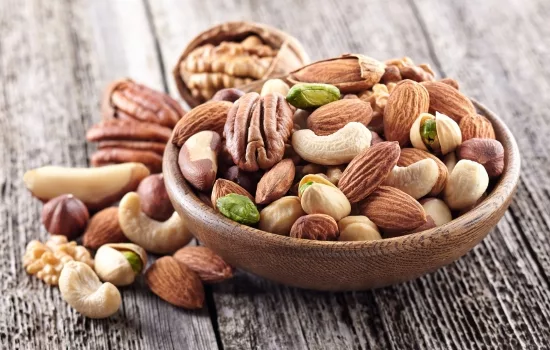
Nutritional Information (28g of Mixed Nuts):
- Calories: 173 Carbohydrates: 5g Protein: 5g Fat: 16g
- Micronutrients: Vitamin E, magnesium, phosphorus, copper, manganese, and selenium.
How Can Nuts Contribute to Muscle Development?
Nuts are rich in protein and healthy fats that provide energy and aid in muscle recovery. Moreover, they contain fiber, which can help with nutrient absorption. Regular consumption can support your overall muscle growth, including your glutes.
Greek Yogurt
Greek yogurt is a creamy, tangy dairy product that’s packed with protein, probiotics, and essential nutrients. It’s an excellent snack or breakfast option for those looking to boost their protein intake. It is made by straining regular yogurt to remove the whey, resulting in a thicker and more concentrated consistency. Greek yogurt is not only delicious but also packed with various nutrients.
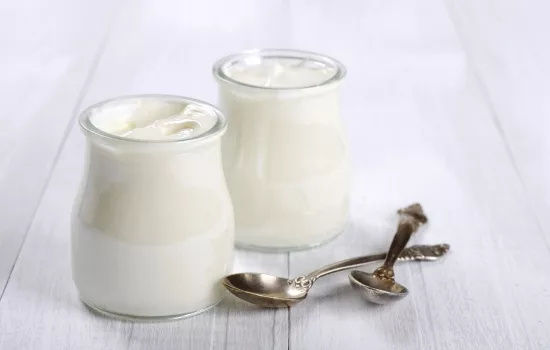
Nutritional Information (200g of non-fat Greek Yogurt):
- Calories: 130 Carbohydrates: 11g Protein: 24g Fat: 0.4g
One of the notable benefits of Greek yogurt is its high protein content. It is an excellent source of complete protein, containing all the essential amino acids needed for muscle growth and repair. A single serving of Greek yogurt can provide around 15 to 20 grams of protein, making it a valuable addition to a protein-rich diet.
In addition to protein, Greek yogurt is rich in calcium, which is essential for maintaining strong bones and teeth. It also contains probiotics, which are beneficial bacteria that promote a healthy gut microbiome and aid in digestion. Greek yogurt is often easier to digest for individuals who are lactose intolerant, as the straining process reduces the lactose content.
Greek yogurt can be enjoyed in various ways. It can be eaten plain, topped with fruits and nuts, or used as a base for smoothies, dressings, and dips. Its versatility makes it a convenient and nutritious choice for breakfast, snacks, or even as a substitute for sour cream in recipes. However, it’s important to choose plain or unsweetened varieties to avoid added sugars.
Also read The Best Night Time Skin Care Routine for Healthy Skin
Avocados
Avocados are unique fruits that are highly regarded for their rich nutritional profile and creamy texture. They are often referred to as a “superfood” due to their numerous health benefits. Avocados are packed with healthy monounsaturated fats, which can help reduce bad cholesterol levels and support heart health.
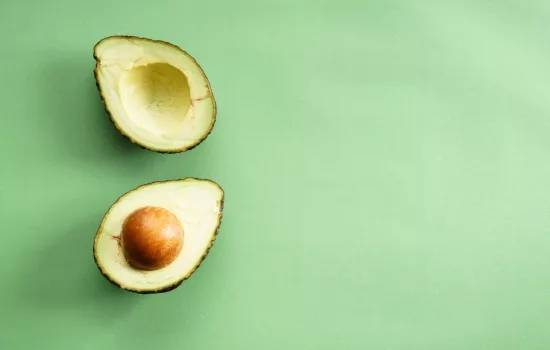
Beyond their healthy fats, avocados are also a good source of fiber. Fiber is essential for maintaining a healthy digestive system and can promote feelings of fullness, aiding in weight management. Additionally, avocados contain a wide range of vitamins and minerals, including potassium, vitamin K, vitamin E, vitamin C, and several B vitamins.
One of the standout features of avocados is their versatility in culinary applications. They can be sliced and added to sandwiches, salads, or wraps, mashed into guacamole, or even used as a substitute for butter or oil in baking recipes. Their creamy texture makes them a popular ingredient in smoothies and as a topping for toast.
When selecting avocados, it’s best to choose ones that are slightly firm but yield to gentle pressure when ripe. To enjoy avocados at their peak, store them at room temperature until they reach the desired level of ripeness. Once ripe, they can be stored in the refrigerator to slow down further ripening.
Salmon
Salmon is a nutrient-dense fish that is prized for its delicious taste and impressive health benefits. It is an excellent source of high-quality protein and is packed with essential omega-3 fatty acids, particularly EPA and DHA. These omega-3 fatty acids play a crucial role in brain health, heart health, and reducing inflammation in the body.
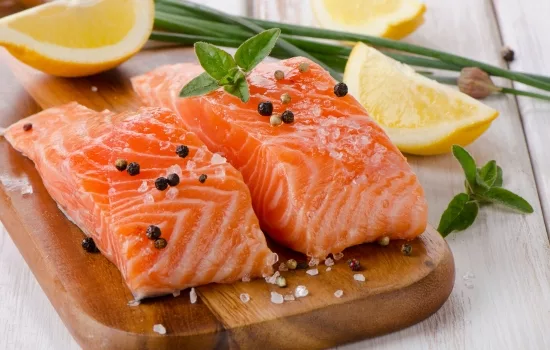
In addition to omega-3 fatty acids, salmon is rich in several vitamins and minerals. It is a good source of vitamin B12, which is essential for nerve function and the production of red blood cells. Salmon also contains vitamin D, selenium, and potassium, among other nutrients.
Regular consumption of salmon has been associated with numerous health benefits. The omega-3 fatty acids found in salmon have been shown to reduce the risk of heart disease, lower blood pressure, and improve overall cardiovascular health. They also have anti-inflammatory properties that may help alleviate symptoms of inflammatory conditions like arthritis.
Salmon can be prepared in various ways, including grilling, baking, broiling, or pan-searing. It pairs well with a wide range of flavors and can be seasoned with herbs, spices, or marinades to enhance its taste. Whether enjoyed as a main course, added to salads, or used in sushi, incorporating salmon into your diet can provide a flavorful and nutritious boost.
Also read Is Banana Good for Weight Loss?
Quinoa
Quinoa is a versatile and nutrient-rich grain-like seed that has gained popularity in recent years. It is native to the Andean region of South America and has been a staple food for centuries. Quinoa is gluten-free and packed with various essential nutrients, making it an excellent choice for those with dietary restrictions or seeking a nutritious alternative to grains.

One of the standout features of quinoa is its protein content. It is a complete protein source, meaning it provides all the essential amino acids our bodies need. This makes quinoa an excellent option for vegetarians, vegans, or anyone looking to increase their protein intake. Additionally, quinoa is rich in fiber, which promotes digestive health and helps maintain stable blood sugar levels.
Quinoa is also a good source of several vitamins and minerals, including manganese, magnesium, phosphorus, and folate. These nutrients play important roles in supporting bone health, energy production, and cell function.
Quinoa can be cooked and used in a variety of dishes, ranging from salads and side dishes to soups and stews. Its mild, nutty flavor complements a wide range of ingredients and cuisines. It can also be ground into flour to create gluten-free baked goods. With its versatility and impressive nutritional profile, quinoa is a valuable addition to any balanced diet.
Legumes
Legumes are a family of plants that includes beans, lentils, peas, and chickpeas. They are highly nutritious and have been consumed for centuries as a primary source of protein and fiber in many cultures. Legumes offer an array of health benefits and are a valuable addition to a balanced diet.
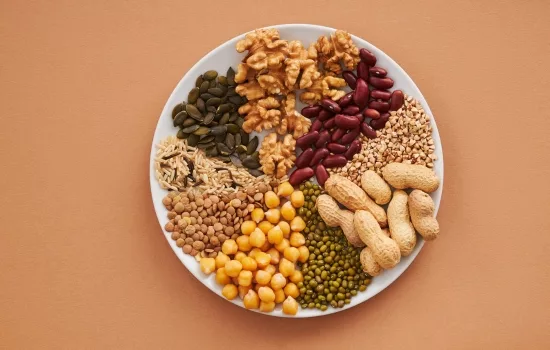
One of the primary advantages of legumes is their high protein content. They are an excellent plant-based source of protein and can be particularly beneficial for individuals following vegetarian or vegan diets. Legumes are also rich in dietary fiber, which aids in digestion, promotes satiety, and supports a healthy gut microbiome.
Legumes are packed with various vitamins and minerals, including folate, iron, potassium, and magnesium. Folate is essential for DNA synthesis and cell division, making it particularly important during periods of rapid growth, such as pregnancy. Iron is crucial for oxygen transport in the body, while potassium and magnesium play roles in maintaining healthy blood pressure and supporting muscle and nerve function.
These versatile plant foods can be incorporated into a wide range of dishes. They can be used in soups, stews, salads, curries, and even as a base for plant-based burgers or dips. Legumes provide an affordable and sustainable protein source, making them an excellent choice for individuals looking to improve their nutrition while reducing their environmental impact.
Now that you know what foods make your butt bigger, it’s time to incorporate them into your diet. But remember, while these foods can help you achieve a bigger bum overnight, you also need to pair them with the right exercises. Squats, lunges, and deadlifts are just a few exercises that can help you sculpt a more voluptuous backside.
Read the trending blog Banana Shake Benefits: Why you should Drink It!
How to Make Your Butt Bigger?
So, how to make your butt bigger? It’s a combination of the right diet and exercise. These ten foods are a great starting point. It’s important to listen to your body and adjust your diet and exercise plan as needed.
As an expert author and fitness enthusiast, I’m here to guide you through the step-by-step process of making your butt bigger. So, let’s get started!
Step 1: Set Your Goal
First things first, it’s important to define your goal. Take a moment to visualize the butt you want to achieve. Set specific, measurable goals that will keep you motivated throughout your journey. For example, you could aim to increase the size of your butt by one inch in the next three months.
Step 2: Plan Your Workout Routine
To make your butt bigger, you’ll need to incorporate targeted exercises into your routine. Squats, lunges, hip thrusts, and glute bridges are excellent exercises that specifically target your glute muscles. Aim to perform these exercises at least three times a week, gradually increasing the intensity and weight as you progress. Remember, consistency is key!
Step 3: Fuel Your Body with Proper Nutrition
Now let’s talk about nutrition. To support muscle growth and achieve a bigger butt, you’ll need to fuel your body with the right nutrients. Incorporate foods that are rich in protein, such as eggs, salmon, and chicken breast, into your meals. These foods provide the building blocks necessary for muscle repair and growth.
Step 4: Embrace Healthy Fats
Don’t be afraid of fats! Incorporate healthy fats into your diet, like avocados, nuts, and olive oil. These fats not only provide essential nutrients but also support hormone production, which is crucial for muscle growth. Remember, moderation is key, so be mindful of portion sizes.
Step 5: Carbs for Energy
Carbohydrates are your body’s main source of energy, especially during workouts. Incorporate complex carbs like quinoa, sweet potatoes, and whole grains into your meals to provide the fuel you need to power through your workouts. However, be mindful of your overall calorie intake and choose carbs that align with your fitness goals.
Step 6: Stay Hydrated
Water is essential for overall health and muscle function. Stay hydrated throughout the day to support optimal performance during your workouts and aid in muscle recovery. Aim to drink at least 8 glasses of water daily, and adjust your intake based on your activity level and environment.
Step 7: Get Enough Rest and Recovery
Rest and recovery are just as important as your workouts. Allow your body time to repair and grow by getting enough sleep and incorporating rest days into your routine. During sleep, your body releases growth hormones that contribute to muscle development. Aim for 7-9 hours of quality sleep each night.
Step 8: Track Your Progress
Tracking your progress is crucial for staying motivated and assessing the effectiveness of your efforts. Take regular measurements of your butt and keep a workout and nutrition journal to note your exercises, weights, and meals. Celebrate small victories along the way to keep yourself inspired.
Step 9: Stay Consistent and Patient
Rome wasn’t built in a day, and neither is a bigger butt. Stay consistent with your workouts and nutrition plan, and be patient with the process. Building muscle takes time, so don’t get discouraged if you don’t see immediate results. Stay focused and trust the process.
Step 10: Embrace the Journey and Have Fun!
Making your butt bigger is not just about the end result; it’s about enjoying the journey. Embrace the process, celebrate your achievements, and have fun along the way. Remember, a positive mindset and a love for what you’re doing will take you a long way.
Also read Top Health Benefits of Chia Seeds.
Final Words
Foods that make your butt bigger are rich in protein, healthy fats, and complex carbs. They provide the nutrients your body needs to build and repair muscle tissue. By incorporating these foods into your diet and pairing them with the right exercises, you can achieve a bigger butt.
Remember, achieving a bigger bum overnight isn’t just about vanity. It’s about health and strength. A strong butt can improve your posture, reduce your risk of injury, and boost your athletic performance. So, don’t just focus on the aesthetics. Focus on the health benefits too.
So, are you ready to start your journey to a bigger butt? With these foods for a bigger butt, you’re well on your way. Just remember, consistency is key. Stick with it, and you’ll see results.
FAQ
Proteins are the building blocks of our bodies. They are essential for the growth and repair of tissues, including muscles. When you consume protein, your body breaks it down into amino acids, which are then used to build new proteins. This process is crucial for muscle growth, including in the butt. Foods rich in protein, like eggs, salmon, and chicken breast, can help you achieve a bigger butt.
Healthy fats, like those found in avocados and nuts, are essential for hormone production, including hormones that regulate muscle growth. They also provide a dense source of calories, which can help you gain weight and muscle mass. By incorporating healthy fats into your diet, you can achieve a bigger, rounder butt.
Carbohydrates are your body’s primary source of energy. They provide the fuel you need for your workouts, allowing you to train harder and longer. They also replenish glycogen stores in your muscles, promoting recovery and growth. Foods rich in complex carbohydrates, like quinoa and sweet potatoes, can help you achieve a bigger butt.
It’s important to remember that muscle growth takes time. It’s unlikely that you’ll see significant changes overnight. However, by consistently incorporating these foods into your diet and pairing them with the right exercises, you can achieve noticeable results over time.
Exercises like squats, lunges, and deadlifts target the glute muscles, helping to shape and tone your butt. By pairing these exercises with the right diet, you can achieve a bigger, rounder, and stronger butt.
Incorporating these foods into your daily diet can be as simple as adding them to your meals. For example, you can have eggs for breakfast, a salmon salad for lunch, and chicken breast with quinoa and sweet potatoes for dinner. Snacks can include Greek yogurt, cottage cheese, nuts, and avocados. Remember, consistency is key. Stick with it, and you’ll see results.
A bigger butt isn’t just about aesthetics. It’s also about health and strength. A strong butt can improve your posture, reduce your risk of injury, and boost your athletic performance. By focusing on the health benefits, you can stay motivated on your journey to a bigger butt.












